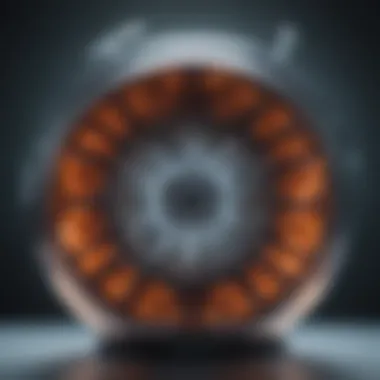Understanding Radiation Therapy Side Effects in Lung Cancer


Article Overview
Radiation therapy plays a crucial role in treating lung cancer. This integral method can effectively target cancer cells while sparing healthy tissue. Understanding the implications of this treatment, particularly its side effects, allows for better management of patient care. This article aims to dissect the various side effects associated with radiation therapy for lung cancer patients.
Purpose of the Article
The primary purpose of this article is to provide a detailed examination of the side effects of radiation therapy specifically in lung cancer treatment. By analyzing how radiation influences both cancerous and non-cancerous cells, readers will gain insights into the possible discomforts they might face. Moreover, this article discusses management strategies that aim to mitigate these side effects.
Relevance to Multiple Disciplines
This exploration is relevant not only to patients undergoing treatment but also to healthcare professionals and researchers. For patients, understanding potential side effects can foster informed decisions regarding their treatment. For healthcare professionals, having a comprehensive knowledge of these effects aids in creating effective management plans. Researchers can utilize this information to enhance studies on improving radiation therapy outcomes.
Research Background
Historical Context
The development of radiation therapy dates back over a century. Early forms gained prominence after discoveries related to x-rays made by Wilhelm Conrad Roentgen in 1895. Initially, radiation was used primarily for diagnostic purposes, but its therapeutic potential became apparent by the early 20th century. As technology progressed, radiation therapy evolved, offering more targeted and refined techniques, particularly in oncology.
Key Concepts and Definitions
To understand the side effects of radiation therapy, it is essential to grasp several key concepts:
- Radiation Therapy: A treatment that uses high doses of radiation to kill or shrink cancer cells.
- Side Effects: Unintended symptoms or reactions resulting from treatment.
- Acute Effects: Side effects that appear shortly after treatment and often resolve within a few weeks.
- Chronic Effects: Side effects that may develop months or years after treatment and can be long-lasting.
"Understanding the nuances of side effects can greatly enhance the quality of life for patients in their treatment journey."
"Understanding the nuances of side effects can greatly enhance the quality of life for patients in their treatment journey."
In summary, this article serves as a comprehensive guide to understanding the side effects associated with radiation therapy for lung cancer. By providing insights into both historical context and key concepts, we aim to prepare readers for a thoughtful engagement with this critical treatment modality.
Prelude to Radiation Therapy
Radiation therapy is a pivotal treatment modality in oncology, particularly for patients diagnosed with lung cancer. Understanding its role is essential for maximizing patient care and improving outcomes. This section outlines fundamental aspects of radiation therapy, emphasizing its definition, historical evolution, and mechanisms through which it exerts its effects on cancerous cells.
Definition and Purpose
Radiation therapy is defined as the use of high-energy radiation to kill or damage cancer cells. It aims to eradicate tumors while minimizing harm to surrounding healthy tissues. The therapy is often employed in several contexts:
- Primary treatment: Used as the main intervention for localized cancers.
- Adjuvant treatment: Given after surgery to eliminate residual disease.
- Palliative care: Relief of symptoms caused by advanced cancer.
By harnessing radiation's capabilities, healthcare professionals can finely tune treatment plans tailored to each patient's unique clinical scenario.
Historical Context
The historical journey of radiation therapy dates back to the discovery of X-rays by Wilhelm Conrad Röntgen in 1895. Subsequent advances in physics and medical technology led to the adoption of radiation for treating various cancers. During the 20th century, significant developments occurred:
- The introduction of cobalt-60 as a radiation source.
- The refinement of techniques, such as 3D conformal radiation therapy, which targets tumors more precisely.
- The emergence of stereotactic body radiotherapy that delivers highly focused radiation in fewer sessions.
These milestones underscore the evolution of radiation therapy as a cornerstone in cancer management, particularly for lung cancers, which present unique challenges due to their location and biological behavior.
Mechanisms of Action
The effectiveness of radiation therapy hinges on its mechanisms of action, primarily the induction of DNA damage within tumor cells. There are two main types of radiation effects:
- Direct Action: Radiation directly ionizes the DNA molecules in cancer cells, leading to immediate damage and cell death.
- Indirect Action: Radiation interacts with water molecules in cells, generating free radicals that subsequently attack DNA, resulting in cellular damage.
This damage triggers cellular repair mechanisms. However, when the damage is too extensive and beyond repair, the cell undergoes apoptosis, or programmed cell death.
Understanding these mechanisms allows oncologists to optimize radiation doses and schedules to enhance efficacy while limiting side effects experienced by patients undergoing treatment.


"Radiation therapy, when used effectively, is capable of transforming the fate of lung cancer patients by improving survival rates and quality of life."
"Radiation therapy, when used effectively, is capable of transforming the fate of lung cancer patients by improving survival rates and quality of life."
In summary, as we delve deeper into understanding radiation therapy, it is crucial to engage with its definition, historical advancements, and mechanisms of action to truly appreciate its role in lung cancer treatment.
Overview of Lung Cancer
Understanding lung cancer is imperative when discussing the side effects of radiation therapy. This knowledge not only provides context but also serves as a foundation for comprehending how radiation interacts with the disease. Cancer involves abnormal cell growth, and in the lungs, this can manifest in various forms. Learning about lung cancer helps in appreciating the nuances of treatment approaches, including radiation.
Epidemiology of Lung Cancer
Lung cancer is a leading cause of cancer-related deaths worldwide. According to the World Health Organization, millions are diagnosed each year, with a significant portion being men and women who have a history of smoking. Non-smokers are also at risk due to factors such as environmental exposure and genetic susceptibilities. The statistics highlight an urgent need for prevention strategies and better treatment options.
Types of Lung Cancer
Lung cancer is primarily categorized into two types: Non-Small Cell Lung Cancer (NSCLC) and Small Cell Lung Cancer (SCLC).
- Non-Small Cell Lung Cancer (NSCLC): This is the most common form, making up about 85% of cases. It generally grows slower than small cell lung cancer and includes subtypes like adenocarcinoma, squamous cell carcinoma, and large cell carcinoma.
- Small Cell Lung Cancer (SCLC): This type is less common but is known for its aggressive nature and rapid growth. It is often associated with extensive metastasis at diagnosis.
Understanding these types is essential for determining the most effective treatment which may include radiation therapy.
Treatment Paradigms
The management of lung cancer often involves a multidimensional approach that incorporates surgery, chemotherapy, and radiation therapy. The choice of treatment is influenced by several factors, including the type and stage of cancer, the patient’s overall health, and personal preferences. Radiation therapy serves a dual purpose: it can either be curative or palliative.
In early-stage lung cancer, radiation might be combined with surgery to improve outcomes. For advanced stages, radiation can reduce symptoms and improve quality of life, particularly for patients with metastases. Overall, it's critical to tailor the treatment paradigm to individual patient needs to optimize survival and alleviate side effects.
Common Side Effects of Radiation Therapy
Understanding the common side effects of radiation therapy is crucial for both patients and healthcare providers. These side effects can significantly impact a patient's quality of life during and after treatment. Early recognition and management of these effects can facilitate better treatment adherence and potentially improve outcomes. It is also important for patients to have realistic expectations regarding side effects, as this knowledge can alleviate anxiety associated with radiation treatment. The side effects experienced will vary based on factors such as the total dose of radiation, the specific area being treated, and individual patient factors.
Acute Side Effects
Acute side effects typically arise during or shortly after the initiation of radiation therapy. They are commonly seen in lung cancer patients. Fatigue is a prevalent issue, with many patients reporting decreased energy levels. Skin reactions, including redness and irritation, often occur in the area being treated. This includes symptoms like dryness or peeling of the skin. Patients may also experience respiratory symptoms, including soreness or a dry cough. Identifying and addressing these acute side effects is vital for maintaining patient comfort throughout treatment.
Chronic Side Effects
Chronic side effects may emerge weeks or months after the conclusion of radiation therapy. These effects can be long-lasting and sometimes permanent, impacting a patient's overall well-being. For instance, pulmonary fibrosis can occur, leading to breathing difficulties. Changes in lung function may contribute to long-term respiratory issues. Another chronic effect includes persistent fatigue, which can hinder daily activities. It is essential for healthcare providers to educate patients about these potential long-term effects so they can prepare more effectively and seek necessary management strategies.
Organ-Specific Complications
Organ-specific complications refer to side effects that affect particular organs due to radiation exposure. Here, we explore three critical areas: pulmonary complications, cardiac effects, and esophageal irritation.
Pulmonary complications
Pulmonary complications are particularly significant as they relate directly to lung cancer treatment. Radiation therapy can cause inflammation of lung tissue, known as radiation-induced pneumonitis. This complication can lead to cough, shortness of breath, and increased susceptibility to infections. The key characteristic of pulmonary complications is their direct impact on a patient’s respiratory function, which is crucial for overall health. Recognizing these complications early allows for timely interventions, such as corticosteroids, which can mitigate the effects. However, managing these complications requires ongoing monitoring and individualized care.
Cardiac effects
Cardiac effects represent another vital concern in radiation therapy for lung cancer. Radiation can impact nearby heart structures, resulting in conditions like pericarditis or even heart dysfunction over time. One of the main reasons to highlight cardiac effects is the potential long-term implications for cardiovascular health. Patients may not notice symptoms immediately; therefore, awareness of this issue is essential. A unique feature of cardiac effects is the variability in patient response, influenced by the radiation dose and existing cardiovascular health. This variability underscores the importance of personalized care approaches in radiation therapy.
Esophageal irritation
Esophageal irritation arises from radiation targeting areas near the esophagus. Patients may experience symptoms such as difficulty swallowing, pain, or a burning sensation. This complication is notable as it can directly affect nutritional intake and overall health. The key characteristic of esophageal irritation is its capacity to disrupt daily life, making it a critical topic of discussion in managing side effects. Recognizing esophageal irritation allows healthcare providers to implement strategies such as dietary modifications or medications to alleviate discomfort. Such management strategies can significantly enhance patient experience during treatment.
Detailed Examination of Side Effects
Understanding the side effects of radiation therapy is crucial for both patients and healthcare providers. These side effects can significantly influence the quality of life and treatment adherence in lung cancer patients. This section delves into specific side effects that patients may face during and after radiation therapy, providing insights into their causes, management, and long-term implications.
Radiation-Induced Pneumonitis


Radiation-Induced Pneumonitis is a common pulmonary complication resulting from radiation therapy for lung cancer. This condition manifests as inflammation of the lung tissue and can occur several weeks after treatment begins. Symptoms may include a persistent cough, tightness in the chest, and shortness of breath. Early recognition is vital, as timely intervention can prevent severe complications.
Monitoring lung function and promptly addressing any respiratory symptoms are essential for minimizing the impact of this side effect on overall treatment outcomes.
Skin Reactions
Skin reactions are another prevalent side effect of radiation therapy. Patients may experience redness, itching, or blistering in the irradiated area. The severity of skin reactions often depends on the radiation dose and treatment location. Proper skin care is paramount. Keeping the area clean and applying recommended ointments can mitigate discomfort. Informing patients about these potential reactions enhances their ability to manage symptoms more effectively and maintain their treatment schedule.
Fatigue
Fatigue is a pervasive complaint among patients undergoing radiation therapy. It can be multifactorial, influenced not only by the treatment itself but also by emotional and physical stressors associated with cancer.
Causes of Fatigue
One of the primary causes of fatigue in lung cancer patients receiving radiation therapy is the body’s response to cellular damage. As the body works to heal, energy is diverted to repair processes, leading to decreased vitality. Additionally, psychological factors, such as anxiety and depression, contribute to this overwhelming sense of fatigue. Educating patients about the physiological basis of this fatigue can help normalize their experiences and provide reassurance about their treatment journey.
Duration and Management
Fatigue can last for weeks or even months post-treatment. This endurance aspect of fatigue can be discouraging. However, it is important to distinguish between normal fatigue and debilitating exhaustion.
Effective strategies for managing fatigue include regular physical activity tailored to the patient's ability, adequate sleep, and stress-reduction techniques. Support groups can also provide emotional support and coping strategies.
Altered Taste and Appetite Changes
Altered taste and changes in appetite are prevalent side effects that can significantly affect nutrition and overall well-being. Many patients report a metallic taste or loss of taste sensitivity, contributing to decreased food intake. Nutritional counseling plays a critical role in addressing these challenges. Offering a variety of textures and flavors can encourage a balanced diet, assisting patients in meeting their nutritional needs during treatment.
Understanding these side effects empowers patients and healthcare providers to enhance management strategies, ultimately improving the patient experience during radiation therapy.
Understanding these side effects empowers patients and healthcare providers to enhance management strategies, ultimately improving the patient experience during radiation therapy.
Factors Influencing Side Effects
Understanding the factors influencing side effects is essential in managing lung cancer patients undergoing radiation therapy. Side effects can vary widely among individuals, shaped by diverse patient and treatment-related elements. Analyzing these influencing factors can enhance patient care and tailor interventions to mitigate discomfort effectively.
Patient-Related Factors
Age and health status
Age and overall health significantly impact how a patient responds to radiation therapy. Older individuals often have a more complex health profile, which can affect their resilience. They may possess comorbidities like cardiovascular issues or diabetes, heightening the risk of severe side effects. In contrast, younger patients might recover quicker and handle the process better due to stronger physiological resilience. This diversity means understanding each patient’s specific age-related health nuances is crucial. It allows clinicians to predict the severity of side effects more accurately.
Concurrent medications
Concurrent medications can complicate the side effects associated with radiation therapy. Patients often take various medications for pre-existing conditions, and these can interact negatively with radiation. For example, anticoagulants may increase bleeding risks, while some medications may intensify fatigue or nausea. Being aware of these interactions is vital for doctors. It facilitates better planning and adjustments to medication regimens, ensuring safety and efficacy during treatment. Key considerations of concurrent medications emphasize the importance of thorough medical assessments before initiating radiation therapy.
Treatment-Related Factors
Dose of radiation
The dose of radiation delivered to the patient directly relates to the side effects experienced. Higher doses may improve tumor control but can also lead to increased incidents of acute and chronic side effects. Clinicians must balance the total radiation dose against the potential for adverse reactions. In this context, employing techniques like intensity-modulated radiation therapy can help target doses more precisely, potentially reducing side effects. Therefore, the dose must be carefully calculated, considering both the therapeutic goals and the patient’s overall well-being.
Location of treatment
The location of radiation treatment can profoundly affect the side effects experienced. Targeting tumors that are near critical organs can lead to varying degrees of side effects in those organs. For example, radiation aimed at lung tumors might affect the esophagus or heart, causing irritation or inflammation. Understanding the precise location allows healthcare providers to develop strategies to minimize damage to surrounding tissues. Employing advanced imaging techniques can assist in planning optimal radiation paths. This detail-oriented approach underscores the necessity of positioning in treatment planning.
Management of Side Effects
Managing side effects in lung cancer patients undergoing radiation therapy is essential for enhancing the quality of life and treatment outcomes. Patients often experience various side effects, some of which can be quite severe or persistent. Therefore, effective management strategies can reduce discomfort, maintain patient adherence to treatment, and ultimately improve overall success in the treatment of lung cancer.
When addressing side effects, it is important to consider individualized approaches that take into account each patient’s specific circumstances. This includes factors such as age, overall health, and the type and location of cancer being treated. Successful management strategies can lead to better patient experiences and potentially increase the effectiveness of the radiation therapy itself.
Symptom Relief Strategies
Medications


Medications play a vital role in managing the side effects associated with radiation therapy. Commonly prescribed drugs include analgesics for pain, corticosteroids for inflammation, and antiemetics for nausea. The key characteristic of these medications is their ability to alleviate symptoms that patients may experience during and after treatment. Pain management, for example, can significantly improve a patient’s comfort, allowing them to engage more actively in their treatment plan.
A unique feature of these medications is that they can be tailored to individual needs. For instance, a patient experiencing severe nausea may require stronger antiemetics than someone with mild symptoms. While medication can be very beneficial, it’s also important to watch for potential side effects from these drugs themselves. In some cases, prolonged use may lead to additional complications, thus necessitating careful monitoring by healthcare providers.
Physical therapies
Physical therapies, including physiotherapy, can also be an effective strategy for managing side effects of radiation therapy. These therapies may involve guided exercises, respiratory techniques, or massage. The key characteristic of physical therapies is their ability to promote general well-being and can help reduce pain and fatigue.
The advantage of physical therapies is that they can enhance the body’s natural healing processes. They can also provide psychological benefits, helping patients feel more in control of their treatment. However, not all patients may tolerate physical activities due to exhaustion or pain, so therapists must customize the approach based on individual comfort levels and capabilities.
Nutritional Support
Nutritional support plays a critical role in managing side effects. Proper nutrition can help maintain strength and energy levels during treatment. Patients undergoing radiation may experience changes in taste or appetite, making it challenging to get sufficient nutrients. A dietitian can work alongside patients to develop meal plans that cater to these changes, ensuring that they consume the right balance of proteins, carbohydrates, and fats to support healing.
Moreover, certain supplements may be recommended to aid in managing fatigue, improve immune function, or enhance recovery from treatments. The goal of nutritional support is to combat the adverse effects of treatment while promoting better overall health.
Psychosocial Support
Psychosocial support is equally important in managing side effects. Lung cancer patients often face emotional stress and anxiety about their diagnosis and treatment. Support groups, counseling, or mental health services can provide a safe space for patients to express their feelings and cope with the emotional burden. This support can reduce feelings of isolation and create a community of understanding.
Additionally, integrative approaches such as art therapy, meditation, or mindfulness can help address the psychological aspect of treatment. These practices can assist patients in managing stress and improving their overall mental health during a challenging time.
Effective management of side effects requires a holistic approach that includes medical, nutritional, and psychosocial strategies tailored to each patient’s needs.
Effective management of side effects requires a holistic approach that includes medical, nutritional, and psychosocial strategies tailored to each patient’s needs.
Research and Innovations in Radiation Therapy
Research and innovations in radiation therapy play a critical role in the evolving landscape of lung cancer treatment. As the field grows, it brings forth new methodologies and technologies aimed at increasing the effectiveness of treatment while minimizing adverse side effects. Understanding these advancements is important for patients and healthcare professionals alike, as they may provide insights into more effective treatment options and improved quality of life during and after therapy.
Emerging technology can lead to a radical shift in how lung cancer is treated, with an emphasis on precision and personalization. This shift is driven by increased understanding of tumor biology and patient variability. Innovations also support the need for tailoring treatment plans that address the unique characteristics of each patient and their cancer.
Advancements in Radiation Techniques
Recent advancements in radiation techniques have significantly enhanced the delivery and impact of radiation therapy. One such technology is Stereotactic Body Radiation Therapy (SBRT). This approach allows for delivering high doses of radiation with remarkable precision. Compared to traditional therapy, SBRT can often achieve better tumor control with fewer overall treatments.
Another notable technique is Intensity-Modulated Radiation Therapy (IMRT). IMRT utilizes advanced computer algorithms to determine the optimal radiation dose distribution. It provides a means to precisely target cancer cells while sparing healthy tissue, thus reducing the risk of side effects associated with radiation exposure. Additionally, Image-Guided Radiation Therapy (IGRT) also supports improved accuracy by using imaging techniques to ensure that the radiation beam is precisely aimed at the tumor during each treatment session.
These advancements not only improve tumor targeting but also foster better patient compliance. With the ability to reduce treatment sessions and side effects, patients experience less disruption in their daily lives.
Investigations into Personalized Therapy
Personalization in radiation therapy is an area under intense investigation, aiming to optimize treatment according to individual patient needs. Research is being conducted on biomarker-driven therapy, where the unique genetic profile of a tumor is used to tailor the radiation dose and technique. This approach can help in distinguishing between tumors that may respond well to radiation versus those that are resistant.
Such research underscores the importance of integrating molecular profiling into treatment decisions. The principal benefit lies in enhancing treatment efficacy while simultaneously reducing unnecessary exposure and associated side effects. For instance, incorporating genetic factors could allow for a more refined approach, identifying which patients might benefit most from specific radiation techniques.
In summary, research and innovations in radiation therapy are not just some future possibilities; they are current realities that are reshaping lung cancer treatment. The advancements in radiation techniques and the exploration of personalized therapy hold the potential for more effective, targeted outcomes that can greatly improve patient experiences. By continuing to explore these areas, healthcare providers can progressively enhance therapies, striving toward optimal care for lung cancer patients.
Ending
The conclusion of this article serves a vital role in synthesizing the intricate information surrounding radiation therapy side effects in lung cancer treatment. This section provides a summary of the primary findings and highlights their significance for affected individuals, healthcare providers, and researchers alike.
Recap of Key Findings
A thorough understanding of the side effects associated with radiation therapy allows for better patient management and care. Key findings include:
- Acute and Chronic Side Effects: Patients may experience both immediate and persistent symptoms stemming from radiation treatment.
- Organ-Specific Complications: Radiation can lead to complications in various organs, such as pulmonary issues, cardiac effects, and irritation of the esophagus.
- Patient-Related Factors: Individual characteristics, including age and concurrent medications, can influence the severity of side effects.
- Management Strategies: Discussing symptom relief strategies, nutritional support, and psychosocial interventions can significantly improve patient outcomes.
"Understanding the side effects of radiation therapy is essential for better patient outcomes and enhanced quality of life."
"Understanding the side effects of radiation therapy is essential for better patient outcomes and enhanced quality of life."
Future Directions in Research
Research focused on improving radiation therapy outcomes continues to evolve. Several promising avenues are currently being explored:
- Advancements in Techniques: Innovations, such as stereotactic body radiation therapy, aim to maximize efficacy while minimizing side effects.
- Personalized Therapy: Future studies may investigate the tailoring of radiation doses based on individual tumor characteristics and patient biology to optimize treatment effectiveness.
- Long-Term Effects: Research on the long-term implications of radiation therapy will provide deeper insights into managing chronic conditions that may arise post-treatment.



